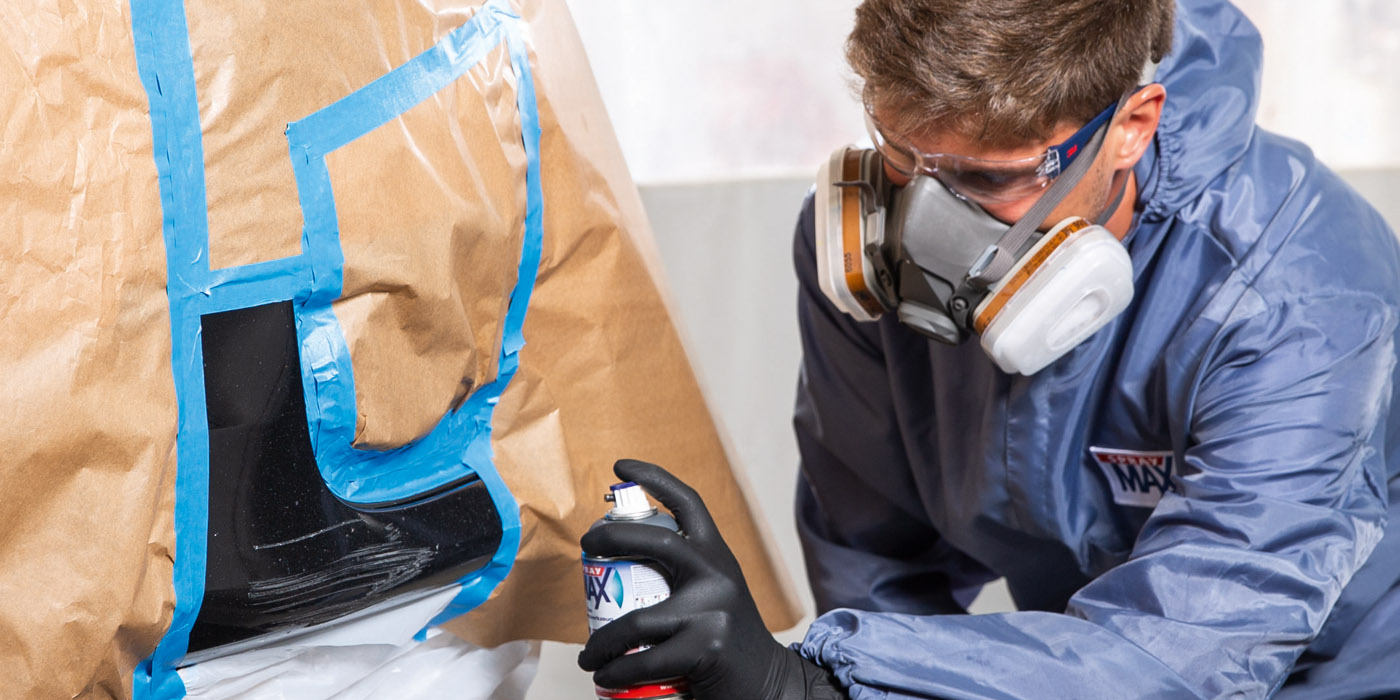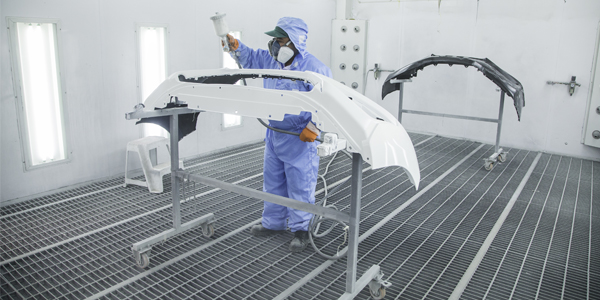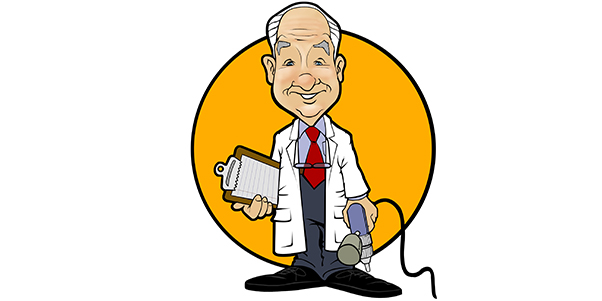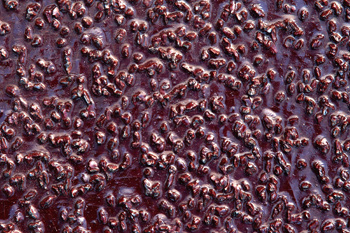 How much difference could there possibly be in sandpaper? Some sand, some paper, some glue. How hard could it be, right?
How much difference could there possibly be in sandpaper? Some sand, some paper, some glue. How hard could it be, right?
Well, it turns out there are some significant differences. How hard was the “sand” used on your paper? The harder the mineral, the longer it lasts. The longer it lasts, the more productive the painter. Labor time is always the most expensive cost in collision repair, or almost any business. If the painter uses sandpaper with really durable minerals, he’ll get more done each day.
How Hard?
Rating how hard or scratch-resistant a particular mineral was inspired by a German geologist in 1812. Friedrich Mohs developed a method of comparing hardness by seeing which minerals would scratch others. Diamonds are at the top of the Moh’s Scale and are rated (10), and talc (hard clay) rated (1) is at the bottom; the higher the number, the harder the mineral. The harder the mineral, the longer it lasts.
The same relative hardness issue also concerned Thomas Turner, a British professor of metallurgy in 1896. He, too, invented a method to measure the scratch hardness of materials. The Turner-sclerometer test consists of “microscopically measuring the width of a scratch made by a diamond under a fixed load, and drawn across the face of the specimen under fixed conditions,” says the scientific community. Turner’s numbers also had talc rated (1) as the softest, and diamonds rated hardest (1600) on his “absolute hardness” scale. And you thought your job was dull!
How hard could it be? It could be really hard but brittle or sort-of hard and less prone to fracture. With diamonds as the hardest, sharpest possible mineral, everything else is some combination of “durable enough” and “pointy enough” to leave lots of consistently deep scratches.
Auto Refinishing
Auto refinishing sandpapers are manufactured to create some combination of the ideal mineral life, the most appropriate backing material, the exact glues to hold it together and the cash outlay for the shop. In researching this story, I spoke to abrasive manufacturers who all had some pretty cool solutions to build their best performing products at their most competitive prices.
Inexpensive sandpaper is built using the cheapest solution to the three coated abrasive building blocks: the mineral, the backing and the adhesive. The end result of the cheapest product is perfectly functional sandpaper. The paint comes off, the body filler is shaped, the clear is scuffed and life goes on.
But…if you built a sandpaper that lasted longer, feathered better, and clogged less by using better minerals, backings and adhesives, you could offer a more productive product and sell it for more cash – a productive product because the shop increases the amount of collision repair work that gets delivered each week. Everyone makes more money, and life goes on – only better.
Two Types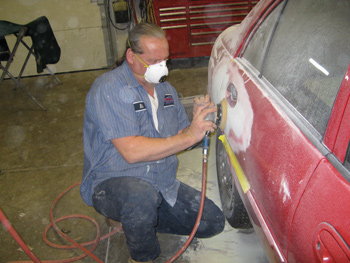
Silicon carbide abrasive is a very hard 9.5 on the Moh’s Scale but toward the bottom side of hardness on the 1-1600 Turner Scale. That means it cuts quickly with a sharp edge but breaks away rapidly. Best suited for fine grit sanding operations, this mineral’s cost is low and will wear away quickly enough to use lightweight (cheaper) backing paper.
Aluminum oxide minerals are all around 9.0 on the Moh’s Scale and include unique blends of aluminum with other minerals and super hot bake temperatures to get the durability/sharpness mix ideal for each use. A very high oven temperature and a mix of the best aluminum oxide blends yields the top-performing ceramic abrasives used in the longest-lasting refinish sandpapers. They require heavier backing papers to match their longer life.
Uniform Size
Now with the perfect “price-value” abrasive identified for our ideal range of product offerings, we need to separate the abrasive particles by uniform size. How deep do you want the scratch to go? There are three scales to measure the depth of the scratch and the size of the “rock.”
The American National Standards Institute (ANSI) created a system to size the mineral particles from low numbers to high. Big particles are low numbers and coarse like 16 grit ANSI grinding discs, and tiny particles are high numbers and leave shallow scratches like 600 grit ANSI wet/dry paper.
In Europe, the common measuring scale is the Federation of European Producers of Abrasives (FEPA) rating methods. Similar in the low-to-high sizing idea but sifted through a tighter sieve, their grit number is preceded by the letter “P” as in a P-320 6-inch by NH (no hole) random orbit sander paper.
In many parts of the world, the common abrasive particle measuring scale is the Japanese Industrial Standard (JIS). This rating system also follows the same “low number = coarse and high number = finer particles” model and uses a tight sieve for very uniform sizes.
However, the higher grits will be numbered differently from the ANSI numbers. For example, an 800 ANSI-sized rock is the same size as a 1200 JIS rock. There is one common grit size that all three measuring methods call exactly the same size: a P-180 FEPA rock, a 180 JIS rock and a 180 ANSI rock.
Sticky Situation
How to fasten the ideal abrasive, in the perfect size rocks, onto the appropriate backing is the next opportunity to save money or improve product performance. From a cost standpoint, the cheapest sandpaper glue is often animal-hide glue, which comes from boiling slaughtered animal carcasses. (And you thought counting minerals was a bad job!)
Better performing and more expensive adhesives are blended to suit the stickiness required to keep the abrasive standing on the backing long enough. Fast fracturing silicon carbide particles wear out quickly and only need enough glue to hold them upright for a short time.
Applied in two coats, the first application of glue to the backing is called the size coat and hopefully has the ideal mix of rigidity (keeps the abrasive upright) and flexibility (allows the abrasive to sway slightly under pressure) to keep the sharpest edges pointed down where they do the most good.
Special sandpapers require special adhesives. Wet or dry papers need waterproof glue; ceramic abrasives last so long you need extra high quality glue to hold them in place for the lengthy sanding times, plus to withstand the high heat generated. Friction from power sanding generates heat, which wants to melt the adhesive holding the abrasive in place. High speed grinding discs that spin at 5,000 to 6,000 RPM generate so much heat and centrifugal force that special resin-bond adhesives are required to keep that 7-by-7/8-inch 36 grit disc sharp, clog free, durable and in one piece.
The second coat of adhesive, called the make coat, is used to ensure the mineral particles are stuck securely and pointed out. In addition to the ability to hold on, longer lasting papers add a soap-like lubricant called zinc stearate to the second coat of adhesive, which helps keep the paper from clogging with the melted paint or body filler. More expensive and longer lasting papers are made with premium blends of adhesives and lubricants. You can tell the manufacturer thinks their version of no-load papers is extra special when they have made them every color of the rainbow. They’re not more expensive than the cheapest sandpapers because they’re colored; they’re more expensive because they’re longer lasting and more productive. But even the ideal mineral in the ideal size with the ideal glue needs something to stick to.
Paper Backings
Sandpaper’s paper backings are measured primarily by their thickness; thicker paper lasts longer, runs cooler and costs more. Based on the weight in pounds of a ream of paper, the different thicknesses are assigned a letter grade. “A” weight paper is thin, and 480 sheets don’t weigh very much. “E” weight paper is much thicker, and 480 sheets weigh many pounds. Use the heavy paper on the most durable minerals; use the thin paper on the finest grits.
Ideal backing requirements also measure flexibility of the material. A 60 ANSI grit machine shop grinding belt would be rated “X” for stiff or “J” for flexible depending on the work they perform. Auto refinish backings also include plastic film. Film backing lends itself well to several pad-attachment methods.
Attachment
With the ideal-for-the-price sandpaper now assembled, it needs to be attached to the power sander’s pad. Some tools still use spring clips at each end of the rectangular pad; it works if the pad has straight edges. On other tools, center bolts hold the round abrasives to the pad. In collision repair, spring clips and center nuts gave way first to tubes of sanding disc glue, then spray cans of disc adhesive, then pressure sensitive adhesives (PSA), then to hook-and-loop fasteners. Generally, faster attachment systems make for more productive painters. Whatever time the technician spends changing grits or worn out sandpaper for fresh ones takes away from working productively on the repair.
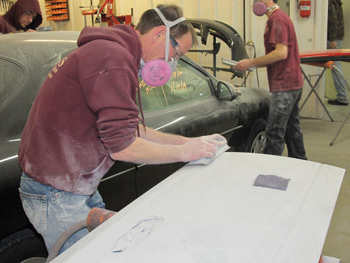 The Ultimate Sandpaper
The Ultimate Sandpaper
What might the ultimate sandpaper look like? At least one abrasive manufacturer has refinish sandpaper that uses industrial grade diamonds as their abrasive mineral. That’s right, a 10.0 on the Moh’s Scale and a 1600 on the Turner makes for the ultimate in uniform scratches and durability. On really scratch-resistant surfaces like today’s clearcoats, gel coats and primers, they predict the diamond particles will last 10 times longer than the best ceramic abrasives. Attached to the tool using a special foam backing and attached to the backing using their best mix of adhesives, they argue that it’s productive and economical to be able to sand all of the next four repairs with the same disc.
Other productive features and benefits of sandpaper construction include adhesive bonding systems that enable the specially-fracturing minerals to sway and produce a finer scratch than their competitors’ versions. Desirable finishing papers would cut quickly but polish easily. Among the variables include how slick the size coat’s lubricant and how rigid the make coat’s hold on the particles is. Each coated abrasive manufacturer believes they have the best combination of price and value at every level of sandpaper quality and shop cost.
Price and Performance
Good stuff costs money to build…and money to buy. A nickel a sheet savings is recovered in four seconds of labor time at $45 per hour door rate. I stand by the long ago time study that calculated that techs in an average paint shop spent one-third of their time sanding something every week. Longer lasting, smoother cutting and niftier construction methods all combine to make the perfect coated abrasive choice for many shops. Americans choose their vendors on a personal combination of competitive price and superior performance.
How much difference can there possibly be in sandpaper? Considerable, as it turns out, and it might work to your advantage to try something new, more expensive yet more productive in your shop this week.
Sanding Best Practices
Clean Surface
Whether you’re sanding to remove the finish, level the finish, feather the finish or polish the finish, pre-cleaning makes for the best adhesion. And that’s why we’re doing most of the sanding, isn’t it? To get the new finish to adhere to the old, quickly and invisibly?
Trite as it seems, one of the most reliable ways to get great adhesion is to simply wash the panel with soap and water. From past experience, I know many shops always wipe with wax and grease remover but never wash with water. However you get the panel clean, test it by tossing some tap water against the repair. Water sheeting off indicates a clean panel, water beading up indicates a not-so-clean panel. Better to find out now than later, when you’ll have to repaint the repair.
Proper Backing Pads
Matching the backing pad to the refinish task is key. Foam pads, rubber blocks, idiot sticks and dozens of power tools all serve to keep the most abrasive possible pressed on the surface all the time. The most productive technicians have every conceivable configuration to suit the concave, convex and flat panels on today’s bodies. Rubbing the surface with a sheet of paper and your fingertips leaves tracks and takes forever. Big flat blocks and power tools make the jobs go way quicker.
Using an inner liner pad between the mounting pad and the sheet of coated abrasive offers a great advantage in coverage, quality and speed. Plus, the sandpaper will run cooler and last longer when the air circulates under the abrasive.
Power Tools
Straight-line, random orbit, oscillating or revolving, every sanding operation goes faster if you can employ a machine to help rub the abrasive around. Find the combination of pad size and motion that does the task the best way for you and get more done every day with the right power sanders.
Guide Coats
Speckling the surface with contrasting color powder or light overspray is a good trick. A guide coat allows the painter to know exactly when the sanding is complete. As soon as the easily visible highs and lows are scraped flat, it’s time to move on. My experience is that painters either like guide coating a bunch or can never ever see the need. As a heads-up, I’ve seen some mighty quick paint shops use them successfully.
Level and Polish Clears
Cushioned foam sanding pads minimize the deepest scratches. Foam polishing pads serve to quickly restore the gloss. Holding a firm but forgiving foam pad flat to the surface and employing the right abrasive or polishing compound will deliver the invisible repair fastest – with a nice margin for error that rigid pads don’t offer.
Scuff Pads and Stripper Wheels
Impregnating abrasive particles in an open mesh plastic web produces a product that does a great job. Scuff pads that distribute the hand sanding compression and conform well to irregular surfaces get any substrate ready for refinishing like nothing else does. How deeply the surface is scratched by any particular color of scuff pad is a function of how hard you push. Harder compression produces a coarser scratch.
Paint is quickly and cleanly stripped off down to the substrate when using the hard spun-glass pads impregnated with long-lasting aluminum oxide abrasives. They’re resistant to loading and easy on the substrate – a win-win. Your mother says to wear eye protection!
Mark R. Clark is the owner of Professional PBE Systems in Waterloo, Iowa; he is a well-known industry speaker and consultant. He is celebrating his 25th year as a contributing editor to BodyShop Business.










